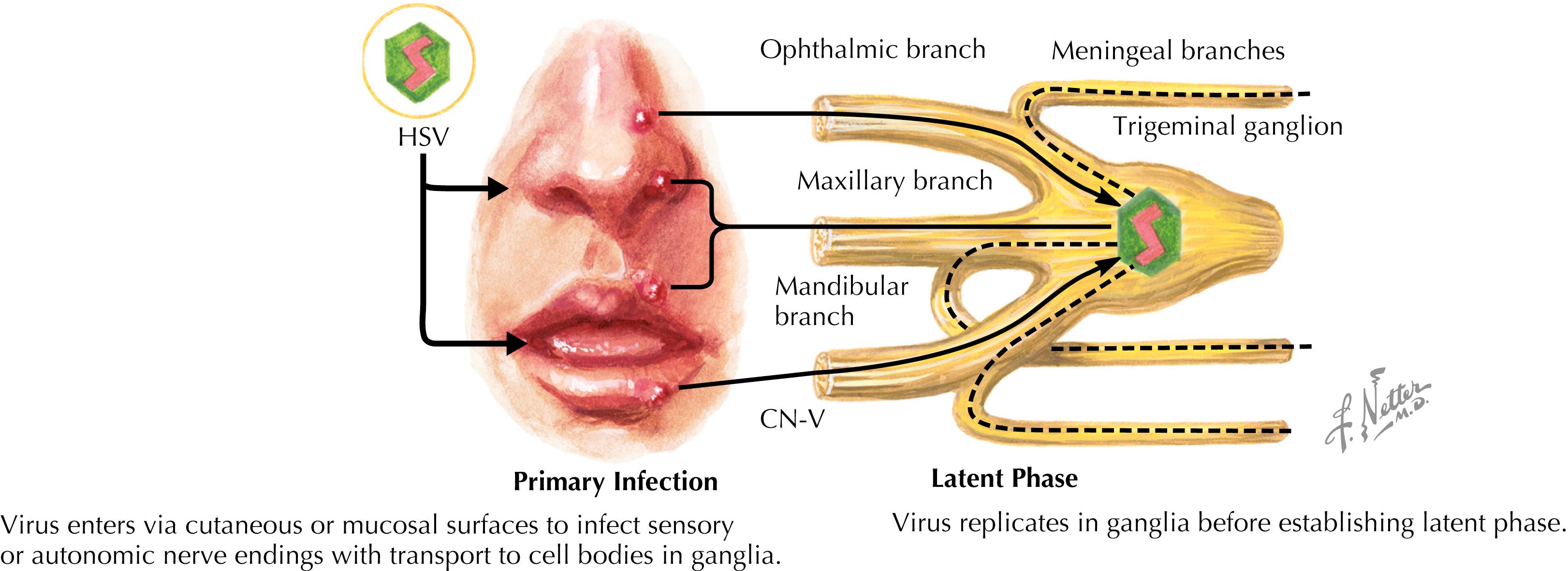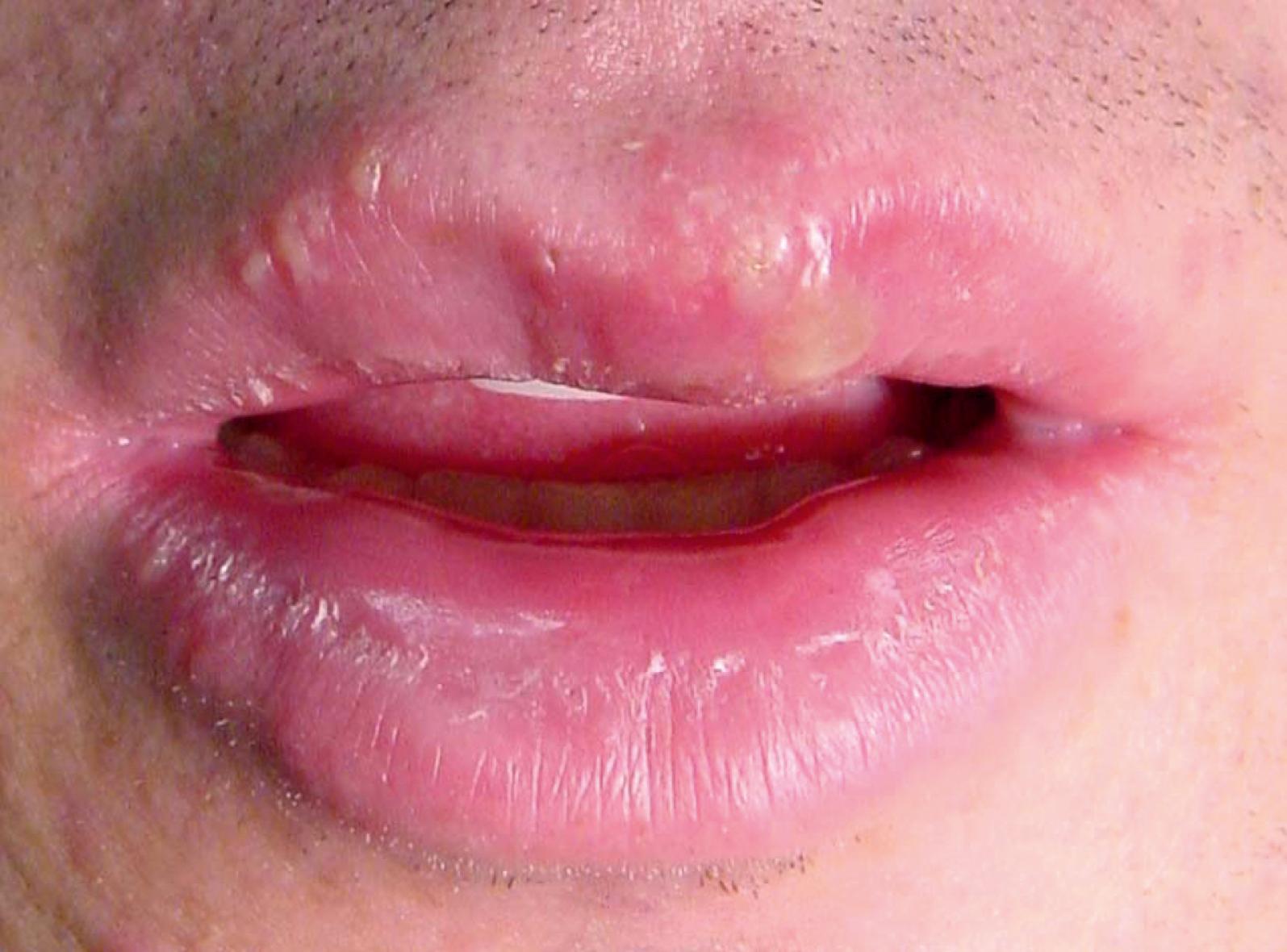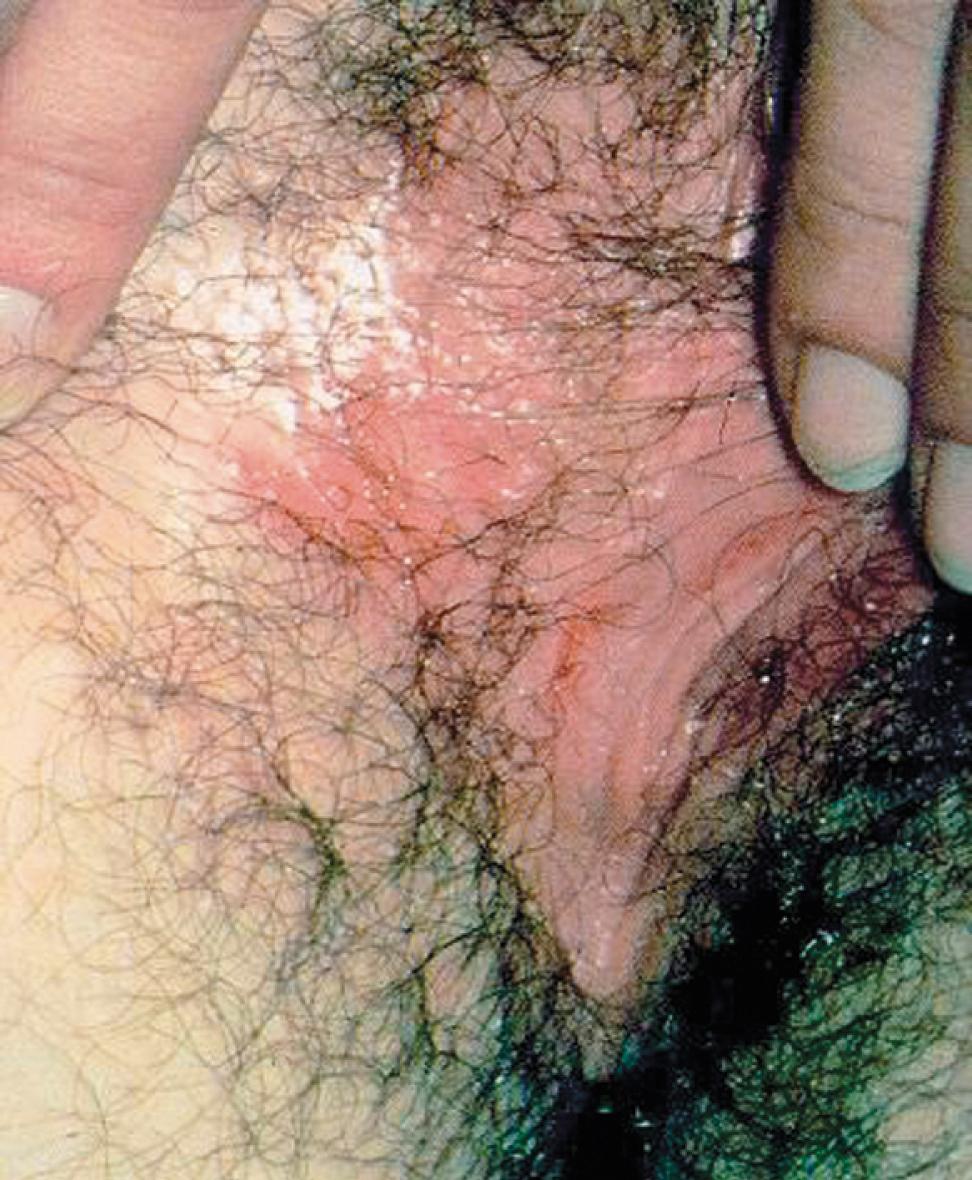Physical Address
304 North Cardinal St.
Dorchester Center, MA 02124
Herpes simplex viruses (HSVs) are double-stranded deoxyribonucleic acid (DNA) viruses that cause lifelong infection and frequent reinfections or reactivations. There are two types of HSV: HSV-1, the cause of human cold sores, and HSV-2, the usual cause of genital herpes. Each virus type has different clinical manifestations, modes of transmission, and epidemiologies. The development of type-specific serologic assays has allowed for differentiation between the two strains of viruses. These sensitive and specific serologic assays have expanded knowledge about the geographic distribution, the burden of disease, and risk factors for HSV-1 and HSV-2. Understanding of these diseases is growing, and there have been advances in both the treatment and the prevention of HSV infections with antiviral medications.
A 20-year-old male presented to his dermatology clinic with a rash on his lower lip. He also endorsed fever, malaise, myalgias, and headaches. The day prior, he had complained of a tingling sensation involving his lower lip. He denies any history of similar rashes, herpes infections, or recent exposures. He admits to a sunburn of his lips after a boating trip the weekend prior. Physical exam demonstrated grouped vesicles, erosions, and ulcers on a faintly red base localized to the vermillion border. A vesicular lesion was unroofed and swabbed for viral polymerase chain reaction (PCR).
COMMENT: This patient is a classic example of herpes labialis occurring after ultraviolet (UV) exposure. Lesions of herpes labialis tend to occur on the outer third of the lips, and the lower lip is more frequently involved than the upper lip. Lesions classically progress through distinct stages, as seen in the patient presented—a prodrome of localized tingling, erythema, papule, vesicle, ulcer, crust, and healing. Diagnosis can be confirmed through viral culture of a young vesicle or PCR for herpes simplex virus DNA. Antiviral therapy can be used to treat acute episodes of herpes labialis or used for prophylaxis prior to high intensity UV exposure. Prophylaxis options include acyclovir 400 mg bid, valacyclovir 500 mg daily, or famciclovir 250 mg bid and should be initiated 24 to 48 hours before exposure, with continuation until removal of the UV exposure.
HSVs are common and ubiquitous worldwide pathogens. There are two identified strains of HSVs: HSV-1 and HSV-2. The most common clinical presentation of HSV-1 infection is herpes labialis, commonly known as cold sores or fever blisters . Herpes labialis occurs in approximately 20% to 40% of the general population and manifests as recurrent vesicular herpetic lesions on the lips or around the mouth. Serologic studies show that approximately 60% of the adult population in the United States is infected with HSV-1, although many infected persons are asymptomatic (i.e., do not have recognized herpes labialis or regular outbreaks).
HSV-2 is the primary cause of genital herpes, which manifests as recurrent genital vesicular and ulcerative lesions. Genital herpes is one of the most common sexually transmitted infections worldwide. The seroprevalence of HSV-2 infection varies widely within the US adult population, but overall it is approximately 20%. This translates to some 60 million infected persons in this country, approximately half of whom have recognized genital herpes disease.
Most HSV-1 reactivations are mild, although uncomfortable and cosmetically disfiguring. In persons with an underlying immunosuppressing disease, active facial and intraoral HSV-1 infection can be persistent and may spread to cause major morbidity. The same is true for HSV-2 infections. Patients with acquired immunodeficiency syndrome (AIDS), for instance, sometimes experience continuous genital or perirectal ulcerations because of persistent replication of HSV-2.
Primary orofacial infection with HSV-1 is predominantly acquired during childhood and is often asymptomatic. Age, socioeconomic status, and geographic location affect the frequency of HSV-1 infection. Women are somewhat more susceptible to genital herpes than men. Other risk factors for HSV-2 infection include a high number of lifetime sexual partners, a history of sexually transmitted diseases, and early age of first intercourse.
Primary infection with HSV occurs via inoculation of the oral or genital mucosa. The virus must contact mucosal surfaces or abraded or eroded skin, where it replicates and initiates infection. HSV-1 is spread primarily via direct contact with contaminated secretions or saliva. HSV-2 is usually spread via sexual contact from infected genital skin or secretions. The spectrum of primary infection is variable, ranging from asymptomatic infection to fulminant gingivostomatitis or genital infection, often with associated constitutional symptoms including fever, malaise, headache, and myalgia. More important, the virus has the ability to ascend through sensory nerve axons to establish chronic, lifelong, latent infection within the trigeminal, geniculate, vagal, and sacral ganglia ( Fig. 23.1 ). These ganglia contain the sensory neuron cell bodies. HSV-1 and HSV-2 do not integrate into the human genome but rather are maintained in an episomal (or extrachromosomal) state within the sensory neuron nucleus.

On reactivation of HSV from its latent state, the virus descends along sensory neurons to reinvade cutaneous tissues, where it appears as vesicles and ulcers. Oral HSV outbreaks are often preceded by a prodrome consisting of localized burning, tenderness, tingling, or pain near the site of reactivation. Other associated symptoms may include headache, fever, malaise, lymphadenopathy, and fatigue. Genital herpes outbreaks are also commonly preceded by prodromal symptoms including dysesthesias and muscle cramping.
Recurrent HSV-1 lesions usually develop on the lower lip but can also be found on the upper lip, nose, cheek, chin, and eyelid ( Fig. 23.2 ). The resultant epithelial cell death and inflammatory response leads to the characteristic vesicular (sometimes even pustular) and ulcerative or necrotic lesions. The lesions of herpes labialis tend to occur on the outer third of the lips, and the lower lip is more frequently involved than the upper lip. Lesions on the nose, chin, or cheeks account for less than 10% of cases. Lesions are most often single; “secondary lesions,” those appearing one or more days after the first sore, develop in one-fifth of cases. From episode to episode, lesions commonly cross the midline of the face or move from one lip to the other if the patient experiences frequent episodes; in patients with infrequent recurrences, the lesion location generally remains the same. The healing time for herpes labialis lesions is variable, with the majority healed within 7 or 8 days. Most patients will have one to three outbreaks per year, but approximately 10% will have more frequent recurrences (more than six lesions per year).

The severity of recurrent herpes labialis is variable, ranging from prodromal symptoms without the development of any signs to extensive disease of both lips and cheeks after severe sunburn. Lesions that do not progress beyond the papule stage have been called “aborted” lesions. Aborted genital outbreaks also occur commonly, especially with early antiviral treatment. Episodes in which there is complete destruction of the epithelium, manifested by the development of the vesicle, ulcer, and/or crust stages, have been called “classical” lesions. Aborted lesions are the outcome of incipient episodes in approximately 25% of cases. Of these lesions, approximately half are limited to prodromal symptoms, with or without erythema, and the others progress to the papule stage before resolving. Although the former are often termed “false” prodromes because of failure of the episode to progress, they are associated with a 60% rate of HSV excretion in the oral cavity and thus appear to be caused by reactivation of the virus. The classic herpes virus lesion progresses through distinct and identifiable stages from a prodrome (localized tingling or burning at the site of herpes reactivation), erythema, papule (edema), vesicle, ulcer, crust (soft debris then hard eschar), and healed (loss of crust).
Well-documented stimuli that appear to induce HSV-1 recurrences in humans include UV exposure (sunburn) of the lips, febrile illness, and menstruation. Some medical procedures also induce herpes labialis, including surgical manipulation of the trigeminal nerve (to treat trigeminal neuralgia), hyperthermia, laser-assisted in situ keratomileusis (LASIK), epidural procedures, chemical or laser resurfacing of the face and others. The mechanisms by which trigger factors induce reactivation of HSV-1 are not completely understood, but they seem to relate to interferon effectors in the skin and/or ganglion.
Primary genital herpes is most often caused by HSV-2 infection, although up to 25% of primary genital outbreaks may be caused by HSV-1, presumably transmitted by oral-genital contact. A patient’s first genital herpes outbreak is typically more severe than subsequent recurrences. Patients with primary genital herpes due to HSV-2 should understand that they are very likely to experience one or more genital herpes recurrences in the next few months. Those with HSV-1 genital disease suffer fewer, and sometimes no, recurrences.
Recurrent genital herpes lesions need not follow a definite primary outbreak; for unknown reasons, some previously HSV-2–infected patients simply begin to have recurrent genital herpes lesions. In men, genital herpes lesions are often vesicular (blisters with clear fluid) or pustular. They are usually painful and most often occur on the shaft of the penis but also are common on the pubis, groin, thigh, buttocks, and scrotum. In women, genital herpes lesions are more likely to manifest as a small ulcer or fissure on the vulva or perineum ( Fig. 23.3 ). Women may also experience genital herpes outbreaks on the pubis, groin, buttocks, or lower back. Men who have sex with men are more likely to have perirectal genital herpes outbreaks. Primary genital herpes may manifest as proctitis in men who have sex with men.

Genital herpes outbreaks are often heralded by a prodrome. Prodromal symptoms include itching, burning, dysuria, and other abnormal sensations in the genital area. Some genital herpes patients may have buttock or leg pain, occasionally mimicking sciatica, as a prodromal symptom. Occasionally, typical genital herpes prodromal symptoms are not followed by a visible outbreak. These “aborted” genital herpes episodes are more common when antiviral treatment is started promptly.
The frequency of genital herpes outbreaks is highly variable, ranging from one every few years to almost monthly, and HSV-2 infection that is completely asymptomatic is not uncommon. Triggering factors are difficult to identify because the outbreaks occur randomly. Some patients believe that stress, vigorous sex, lack of sleep, or sun exposure leads to outbreaks. Most lesions heal in 1 to 2 weeks. Genital herpes lesions can be very severe and persistent in immunocompromised individuals, including those with AIDS.
Become a Clinical Tree membership for Full access and enjoy Unlimited articles
If you are a member. Log in here